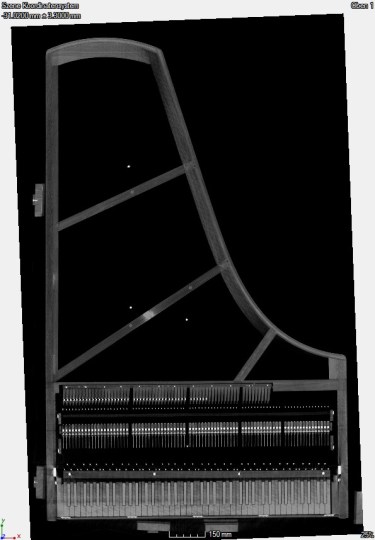if you’re into baroque music, I can tell you that Germans sure are. So it’s no surprise that German R&D outfit Fraunhofer has twisted its substantial funds towards..
learning about and safeguarding every little information of the instruments for which the likes of Bach and Handel composed their music. precisely, they’re putting them into an enormous x-ray machine.
There are few thousands of that kind of instruments, from woodwinds to pianos, On the other hand, many of them are too expensive to take apart, or too flexible to display.
For a country whose history is so rich in music, it is a shame that the object of such a serious period like the baroque should be locked away. It’s is idem with other museums, which have so much space to display their collections — so why not digitize them and display them that way?
In order to study and perhaps reproduce these historic instruments, researchers created the Musical Instrument Computed tomography Examination Standard, or MUSICES.
 Functioning for two years now, the project has scanned more than a hundred instruments at Fraunhofer’s Development Center for X-ray Technology, or EZRT. They have also scanned all kinds of interesting things in the past in their huge-format devices, but this instrument project is especially culturally significant.
Functioning for two years now, the project has scanned more than a hundred instruments at Fraunhofer’s Development Center for X-ray Technology, or EZRT. They have also scanned all kinds of interesting things in the past in their huge-format devices, but this instrument project is especially culturally significant.
The XXL X-ray environment (that’s what they call it) “consists of two eight-meter-tall steel scaffolding towers and a turntable with a diameter of three meters, accomodated in a hall covering a surface area of 400 square meters and rising to a height of 14 meters.” That’s XXL, all right.
That amount of space lets them safely scan a grand piano, as you see at right. (The top image, in case you were wondering, is a box-valve trumpet.)
It’s not only about making an inventory of the things, though. The researchers are learning as they go. What settings work best for what materials? What resolution is sufficient for duplication ? What formats should the resulting models and imagery be dispersed as? How long does it take? (Answer to that last one: quite long. A violin at 50 microns resolution takes up to 20 hours.)
“preferably, we would like to be able to digitize the museum’s complete collection of historical musical instruments and putthe 3D images online. Our examination standard defines the best way to go about this task,” explained Fraunhofer’s Theobald Fuchs, who headed the project, in a news release (digitize is his word). “The CT digitization project will let us to create a virtual museum in which digital facsimiles of these instruments are accessible to anyone with internet access.”
The team intend to release at some part of the research early next year, at which point the suggestions and parameters they set forth may perhaps be taken up by any other interested party with a two-story X-ray machine.




